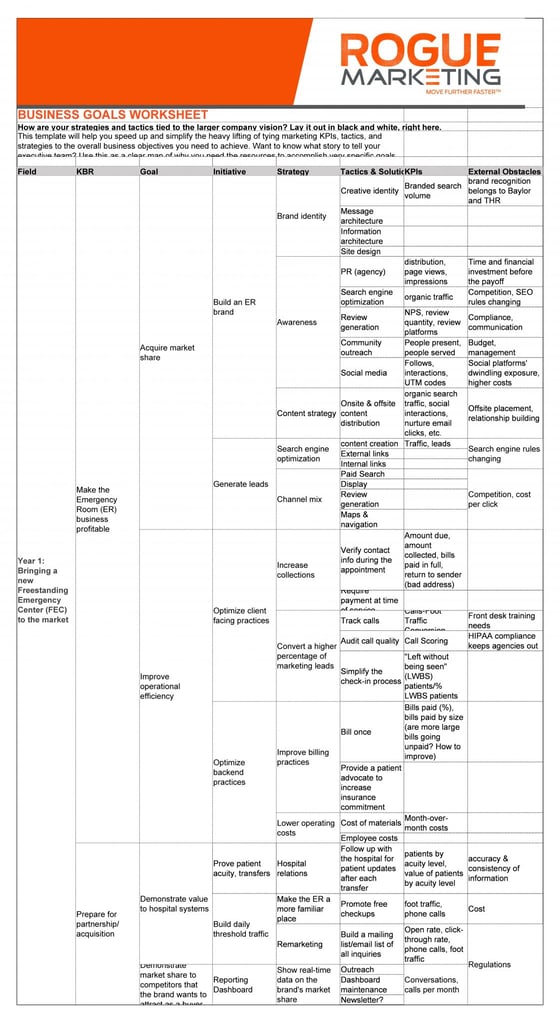The Marketing Process You Need to Know for Better Results
The two most important roles at a company are those of innovation and marketing.
4 min read
![]() Rogue Marketing
Sep 30, 2019 10:42:42 AM
Rogue Marketing
Sep 30, 2019 10:42:42 AM
If you’ve encountered Rogue, whether just online or regularly as one of our clients, you know how important frameworks are to the way we practice both business consulting and business marketing. Today we’re diving into a framework for marketing business contributions. This framework helps do BOTH business consulting and marketing.
You know what the executive team agreed to at the last retreat. But where is that documented? After key leadership meetings, you know what happens—the months pass, teams are working away on their initiatives, and one day you pop your head up from the demanding pile of tasks and ask, “Do I really know where all of this is going? I know where we wanted it to go…but how can we analyze if we’re getting there?”
This template will help you speed up and simplify the heavy lifting of tying marketing KPIs, tactics, and strategies to the overall business objectives you need to achieve. Want to know what story to tell your executive team? Use this as a clear map of why you need resources to accomplish very specific goals.
Here’s an example for a freestanding ER clinic preparing for acquisition. Let’s talk about what we see here, and how to make this a usable document in your organization.

Operations, for example, will have different strategies and tactics than marketing in order to participate in an initiative. But when all departments know that they’re rowing in the same direction, and are actively supporting each other as they move that way, you create more efficiency and synergy than when you assume everyone “gets it already.”
Let’s dig into the columns:
Field – What do you want to change in your market? In this example, the client wanted to bring a new freestanding ER business to a densely populated area.
Key Business Requirement (KBR) – KBRs tend to act as north stars. You can always move toward them, but they aren’t always “done.” Your KBRs are the answers to the question, “What are the things we need to be working toward in order to change our field the way we want?” In this example, the client knew that to build a new brand in the crowded healthcare market, the brand needed to prove profitability, and they wanted to have the vision of preparing for acquisition (which they did, in fact, accomplish within 18 months). There are usually at least two KBRs.
Goals – What are the tangible outcomes that show you are moving toward your KBRs? What matters most to your organization’s profitability? The company goals aren’t ready yet to be department specific. In this example, “increase market share” is just as applicable to product development as sales, marketing, operations, and technology. There are usually at least two goals per KBR.
Initiatives – This is where departments start to separate and define what they can do to contribute to reaching company goals. This example shows marketing-specific initiatives, and you’ll notice that they’re high-level—you see “generate leads,” not “run Google Display ads on a retargeting network”. Make sure you’re leaving enough room to say what and why before you get into the how. This way you open the door for innovation.
Strategies – Strategy is a blanket term: it’s so ill-defined that people use it to cover anything. You could rightly argue that this entire template qualifies as strategy, so what’s it doing all the way down at the fifth column? In this context, strategy is how you plan to amass and deploy specific resources in order to reach a specified target—in this case, the initiative. You have plenty of options, and none of them are easy to point to and say, “Well of course we’re going to target that audience, on that channel, with that message…it’s obvious!” It’s not obvious. It takes planning. It takes…strategy.
Tactics & Solutions – This is where the wood gets chopped. When you have already defined the previous 5 stages, your individual tactics and solutions are more easily assessed. There’s not a question of if your social media campaign should be focused on clicks, or followers, or form fills. The path is laid out, and the company is working in sync to that end.
KPIs – Once you’re spending money (human capital, contractors, agencies, ad budgets, etc.) you need to know what success looks like. How are your tactics and solutions going to be deemed a successful part of the strategy? Though there are many metrics you can look at along the way, you typically have a very small number of metrics you’re ultimately looking for. Spell them out here, and watch to make sure you’re not measuring the wrong numbers.
External Obstacles – There are things you can’t control. And there are things you can control, with some more effort. Every business leader that ever said “this is easy” didn’t understand how hard it really was. By outlining the obstacles you are facing or will likely face, you eliminate at least some of the shocked looks when you say you need more resources in order to get around the problem.
This framework is mostly a business consulting document, with an example built around marketing. But it is just as applicable for any other part of the business. The more your entire organization is aligned on the first half of this document, the more you work in sync to move your business further, faster.
There’s an entire bundle of frameworks that you can use to align marketing, operations, and sales once you’ve agreed on the goals: We call it the Operational Alignment Bundle.
Rogue’s Operational Alignment Bundle has the templates and tools to help you do the heavy thinking before you do the heavy lifting required for explosive marketing growth.
Templates make the work simple, but that doesn’t mean the work isn’t hard. That’s where Rogue can help. If you’re ready to work with a group that thinks about marketing from the perspective of the rest of the business, then there’s a group of rogue marketers who can help. We’re just a click away.
If you’re ready to move further, faster, talk to Rogue today.

The two most important roles at a company are those of innovation and marketing.

You live and work in a fast-paced business climate. Attention now. Activity now. Results now. (Or, if you consider yourself a bit more realistic…...

The political landscape is an incredible mirror of the culture and business world you and consumers operate in today. Though you may not have...